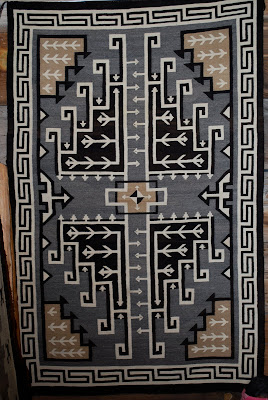We spent this past weekend doing some sightseeing…I think Heinz was trying to bribe me, if we played all weekend, he could fish all day for the following four days until we leave - that worked for me.
Saturday we headed west and went to Shiprock, NM to check out the Begaye Flea Market. The market wasn’t much, 30 or so vendors, mostly selling used tools, clothes, etc., but there were some selling jewelry, and I picked up a great pair of earrings made of silver and White Buffalo turquoise that goes really well with the bracelet I got in Gallup.
Leaving town we headed south and went to see the rock formation called Ship Rock (Tse Bit’a’I - winged rock - in Navajo). It rises to almost 1,800 feet from the desert floor. The only road that runs past the base of the rock is a two wheeled rutted dirt road, not recommended for anything but four-wheeled vehicles, so we stayed on the paved road and viewed it from a distance.
Ship Rock (on the right)
Driving out to Ship Rock we noticed signs for Toadlena Trading Post featuring Navajo rugs - so off we went another 25 or 30 miles southwest. The store opened in 1909 and has worked with the local weavers of the Two Grey Hills area ever since. Along with being a traditional trading post, where you can buy anything from flour to aspirin to clothing, the post has a small museum exhibiting Navajo rugs. The owner told us that he changes the exhibit every two years. Right now the exhibit is of rugs woven by the women of one family from 1900 to the present day. The owner gave us a great little orientation to Navajo weaving, and explained that completion of a rug can take up to 6 months for a small one and a year for a large one. The women raise their own sheep, shear them (no electric shears here), and wash and card the wool by hand. This step can take up to 3 months. Then the weaving starts, this step is 3-6 months (or more) per rug. The fastest weavers can only complete 2 rugs a year. While we were there we were introduced to two of the local weavers, neither looked to be younger than 75 years old. The weaving is apparently becoming a dying art, as the young people are not interested in spending the time necessary. After hearing all that (and seeing the price for a small 8” x 12” mat …$175) we were too scared to ask the price of a full sized rug!
Antique rug from the 1920’s, still in almost perfect condition
Inside the Toadlena Trading Post
It was kind of interesting getting off of the main highways and on to the smaller roads on the Navajo Reservation. The houses were scattered a mile or more apart and you could barely see many of them in the distance. All of them had roads going out to them that were rough two wheeled rutted dirt roads. In addition, the livestock all ran free with no fences to keep them in and off the roads.
Sheep along the road to Toadlena NM
A sheepdog and his charges
On Sunday we headed north to visit Mesa Verde National Park in southern Colorado. National Geographic Traveler named Mesa Verde as one of the fifty “must see” places of a lifetime and it’s easy to see why. The beauty and complexity of the homes and villages here tell quite a story about the early Puebloan (aka Anasazi) cultures. The area was first populated around 750 AD and started with pit houses partially built in the ground and partially above. By 1000 AD the people of Mesa Verde had advanced to stone masonry and continued to the late 1270’s when the area was abandoned for unknown reasons. We drove the loop roads looking at the ruins along the cliff walls and the pit houses that have been excavated. Then after lunch we took the Cliff Palace tour.
Heinz checking out Balcony House across the canyon
Cliff Palace
Check out the cracks in the rock slab. Archeologists have found evidence that the crack was there centuries ago and that the Ancestral Puebloans made efforts to shore it up with adobe plaster.
Cliff Palace was estimated to have 150 rooms, three stories and house around 100 -125 people at its peak
Painting on the wall of an interior room, estimated to have been painted around 1100 AD.
Toeholds used by Puebloan people to move from between their farms on the mesa tops down to the cliff dwellings and back. Imagine climbing/descending on these with a clay pot of water on your head, or groceries on your back. Slip and you're looking at upwards of a 600 foot fall to the canyon bottom.
The weather is turning nice, warming up in the afternoons, while still cool at night. The wildflowers are starting to bloom and the trees are budding out. However, there is still snow up in the mountains.
Wildflowers at Mesa Verde
Wildflowers at Mesa Verde
San Juan Mountains, Colorado
Heinz spent Monday fishing, caught a nice one in the catch-and-release area and another couple in the catch and keep. Unfortunately, they got away (AGAIN), so salmon was on the menu for dinner instead of trout. On Tuesday he brought home two nice sized rainbow trout, so I sautéed them in some butter and olive oil, then browned some parsley and pecans in the butter/oil to drizzle on top of them. They were absolutely delicious.
Rainbow trout with pecans
And our friends of the day…

















No comments:
Post a Comment